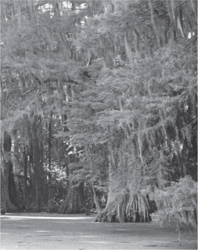
GLOSSARY

clutch A batch of eggs. “Clutch size” means how many eggs are hatched in a single batch. Birds are said to “double clutch” if they lay two batches of eggs in a breeding season. The Ivory-bill had the smallest clutch of any North American woodpecker, two to three eggs.
ecological niche The sum total of a given organism’s relation to its environment, such as where it lives and what it eats. Often the combined activity of different organisms accomplishes a common purpose. The Ivory-billed Woodpecker pried up the bark of dying trees to get at its food. This opened the door for still other creatures to bore into the trees. The trees continued to decompose until eventually they became too weak to stand and fell to the ground, opening holes in the canopy of treetops for sunlight to pour through and illuminate the ground so that new seeds could grow.
ecology The study of how plants and animals relate to one another and to their physical environment.
ecosystem A natural community of plants and animals along with the elements of their physical environment, such as soil or a river. No plant or animal can live alone in nature; all living creatures depend on the lives of others and on the environment they share. An ecosystem is a sort of biological neighborhood.
egret One of several varieties of white heron. The name comes from long plumes called “aigrettes” grown by males during the breeding season.
endemic A word describing a species that lives only in one place. For example, the Bee Hummingbird, the world’s smallest bird, is endemic to Cuba, meaning that it lives only there. The Ivory-billed Woodpecker was not endemic to the United States because there was also a population in Cuba.
evolution A change in the genes within an entire population of a species by processes such as mutation and natural selection.
extinction The state of no longer being in existence anywhere.
extirpation Local extinction. The Ivory-billed Woodpecker probably became extirpated in Louisiana when the Singer Tract was cut, but it did not become extinct, since there was a population still alive in Cuba.
gene The basic unit of heredity, carried on a chromosome and transmitted from parent to offspring.
grub The larva of a beetle. The grubs that Ivory-bills loved came from three families of the huge order of beetles named Coleoptera.
habitat A place where a bird or other animal lives, or where we go to find it. It is the place that contains all that a certain animal needs to eat and reproduce.
heron A tall, long-legged wading bird with a long neck and a long, tapering bill that is used to catch fish and other food. Herons’ closest relatives are storks, ibises, and flamingos.
migration The regular movement of birds between their breeding and nonbreeding areas. This movement is usually seasonal and repeated each year. Some birds, such as the Lesser Golden Plover, fly many thousands of miles in migration each year. Birds migrate for many reasons, including to encounter less competition, to avoid predators, to find more food, to find increased sunlight for feeding and reproduction, and to avoid harsh weather. The Ivory-billed Woodpecker flew long distances to find food, but it did not migrate.
natural selection The process through which forms of life survive and reproduce better than others of their kind by developing traits that allow them to adapt to environmental pressures. For example, over time, each of Darwin’s fourteen finch species on the Galápagos Islands evolved from a single founding species through the development of traits—such as different bill shapes—that let them find new sources of food and produce more offspring.
predator An animal that seizes and eats other animals. The birds most frequently thought of as predators are hawks, eagles, and owls.
preening Taking care of feathers by fluffing them out and then combing them with the bill. Birds spend a lot of time preening. They preen to make sure that all their feathers are in place, correctly interlocked, and well oiled. Most birds squeeze oil from a gland at the base of their tails onto their bills, which they then use to spread the oil over their feathers. This keeps the feathers from drying out in the sun and keeps birds that live in water warm.
roost A place where birds sleep, and also the act of sleeping in that place. Some birds, such as blackbirds and starlings, roost together in giant flocks, covering trees or bushes at night. Woodpeckers sleep inside cavities, or holes, chiseled into trees.
species The most basic category into which living things are divided. A species of bird is a kind of bird—such as an Ivory-billed Woodpecker, or a Blue Jay, or an American Robin. But what makes a species a species? One well-respected theory says that a group of birds is a species if the group is reproductively isolated from other groups of birds. This means that members of the group can reproduce only with each other. By this definition, if they tried to reproduce with birds that were not of their species, any young bird that was born could not produce young birds of its own. The question “What makes a species a species?” is still hotly debated among biologists. In other words, it is evolving.